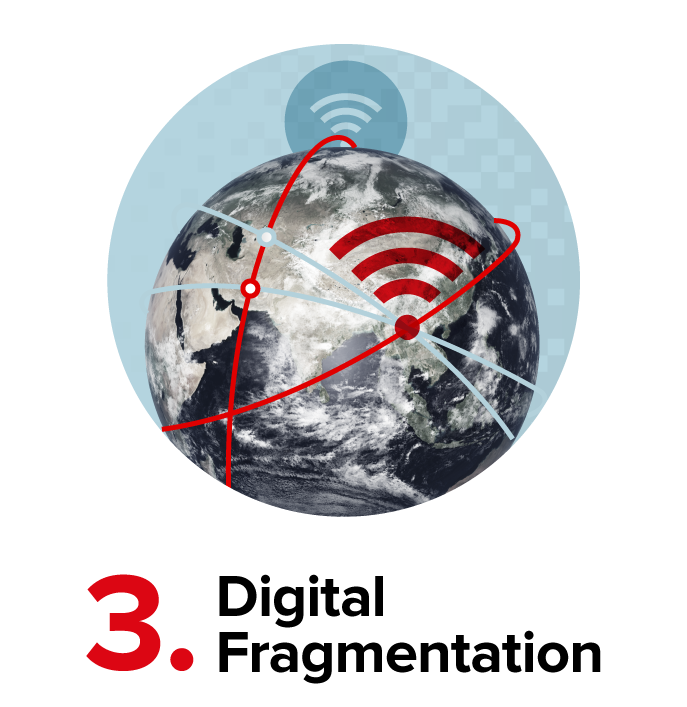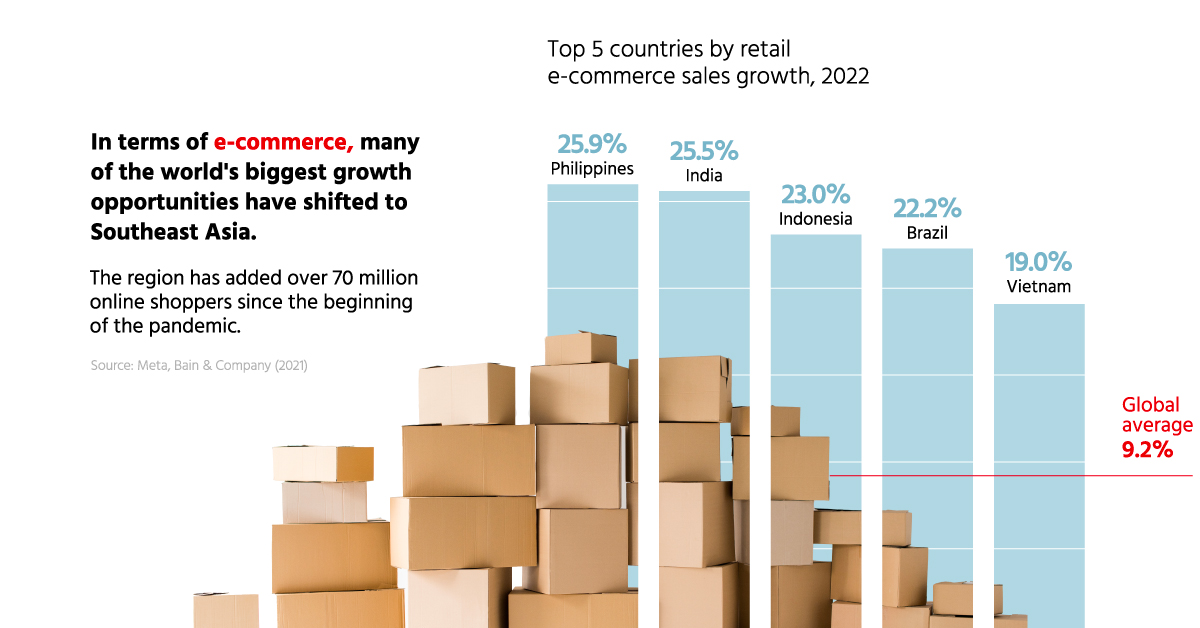Global Trade Series: Asia’s Digital Economy

Global Trade Series: Asia’s Digital Economy
Over the past several decades, Asia has enjoyed robust economic growth.
Historically speaking, most of this growth was concentrated in China, and was due to a rapid expansion of manufacturing capability. Today, economic growth is being increasingly driven by the digital economy, and it’s spreading to many more countries in the region.
In this infographic from the Hinrich Foundation, we take a closer look at how trade and digitalization is shaping Asia’s future.
A Historic E-Commerce Boom
It’s well documented that the COVID-19 pandemic was a catalyst for greater e-commerce adoption. In the U.S. for example, e-commerce’s share of total retail sales grew from 11% in 2019 to 15.3% in 2021.
This trend is even more pronounced in Southeast Asia, where the number of online shoppers has increased by 70 million since the beginning of the pandemic. For context, that’s roughly equal to the entire population of the UK.
Furthermore, if we look at the top five countries by e-commerce sales growth in 2022, three are located in Southeast Asia. Widening our scope to Asia in general, this climbs to four out of five.
| Country | Region | Annual sales growth (%) |
|---|---|---|
| Philippines | Southeast Asia | 25.9% |
| India | South Asia | 25.5% |
| Indonesia | Southeast Asia | 23.0% |
| Brazil | Latin America | 22.2% |
| Vietnam | Southeast Asia | 19.0% |
| Global average | -- | 9.2% |
Underpinning this growth is Asia’s embracement of the super app—an application that includes many digital services under one umbrella. Examples include South Korea’s Kakao (53M users), Singapore’s Grab (180M users), and China’s WeChat (1B users).
These services originally served a single purpose such as messaging, but have since grown into massive ecosystems where businesses and consumers can connect. Under the WeChat umbrella, users can access digital payment services, social networks, food delivery, shopping, and more.
Beware the Digital Divide
Unique challenges are threatening the growth of Asia’s digital economy. Here are three examples.
1. Digital Neo-Mercantilism
Neo-mercantilism is a regime that uses trade restrictions (limiting imports) as a means of increasing domestic income and employment. These policies are becoming more common in the digital economy, especially between the U.S. and China.
In 2019, the U.S. blacklisted Huawei, restricting it from doing business with domestic firms such as Google. This continues to significantly hamper the company, which was once the world’s largest smartphone manufacturer. In China, a similar story is unfolding. Data restrictions and other regulations have famously driven out American tech firms such as Uber and Yahoo.
2. Skills Gaps
Due to technological innovation, more and more businesses are looking to hire people with digital skills. For context, a 2021 survey of over 2,000 employers across Asia-Pacific found the most in-demand skills to be:
- Using cloud-based tools such as CRM software
- Developing and deploying cybersecurity protocols
- Managing migration from on-premises to the cloud
- Providing technical support
- Digital marketing skills
Unfortunately, 67% (two thirds) of Asian workers don’t feel confident that they’re gaining these skills fast enough. Among people aged 55 and above, this percentage rises to 83%.
If governments and businesses fail to adequately invest in education, it’s likely their country will fall behind. The survey also found that 97% of organizations recognize the need for digital training, but just 29% had a plan for doing so.
3. Fragmented Regulatory Landscape
Inconsistent regulations across Asia are having a negative impact on businesses.
For example, in 2021, eTrade Alliance surveyed 1,300 firms in Southeast Asia. A key finding was that 30% of businesses had lost an online sale due to cross-border payment restrictions. Resolving these issues should be a top priority, especially given the region’s rapid growth in number of online shoppers.
Some countries such as Thailand have made progress in improving payment interoperability. Its central bank recently launched a QR code payment system with Laos, Cambodia, and Vietnam. Thailand has also cooperated with Singapore, allowing customers of participating banks to transfer up to $800 daily between the two countries.
Recent Trade Agreements Involving Asia
Here are three major trade agreements that are likely to impact Asia’s digital economy.
1. CPTPP
The CPTPP (Comprehensive and Progressive Agreement for Trans-Pacific Partnership) is a trade agreement among 11 nations, signed in 2018.
It features a comprehensive e-commerce chapter that standardizes digital trade rules and ensures the free flow of data. See below for a list of member countries.
| Signatories | GDP (USD trillions) | Population |
|---|---|---|
| Australia | $1.54 | 25,739,000 |
| Brunei | $0.01 | 441,532 |
| Canada | $1.99 | 38,246,000 |
| Chile | $0.32 | 19,212,000 |
| Japan | $4.94 | 125,681,000 |
| Malaysia | $0.37 | 32,776,000 |
| Mexico | $1.29 | 130,262,000 |
| New Zealand | $0.25 | 5,122,000 |
| Peru | $0.22 | 33,359,000 |
| Singapore | $0.40 | 5,453,000 |
| Vietnam | $0.36 | 98,168,000 |
| Signatories Total | $11.69 | 514,459,532 |
| Global total | $96.1 | 7,840,000,000 |
Altogether, CPTPP signatories represent 12.2% of global GDP, and 6.6% of global population.
Recent research on the impacts of CPTPP suggest that the agreement has already benefitted businesses. Among 530 firms surveyed, 36% said the CPTPP helped them diversify into new markets, while 45% said it helped them gain more foreign customers.
2. RCEP
The Regional Comprehensive Economic Partnership (RCEP) is a trade agreement among 15 Asia-Pacific nations, signed in 2020. See below for a list of member countries.
| Signatories | GDP (USD trillions) | Population |
|---|---|---|
| Australia | $1.54 | 25,739,000 |
| Brunei | $0.01 | 441,532 |
| Canada | $1.99 | 38,246,000 |
| Chile | $0.32 | 19,212,000 |
| Japan | $4.94 | 125,681,000 |
| Malaysia | $0.37 | 32,776,000 |
| Mexico | $1.29 | 130,262,000 |
| New Zealand | $0.25 | 5,122,000 |
| Peru | $0.22 | 33,359,000 |
| Singapore | $0.40 | 5,453,000 |
| Vietnam | $0.36 | 98,168,000 |
| Signatories Total | $11.69 | 514,459,532 |
| Global total | $96.1 | 7,840,000,000 |
Chapter 12 of this agreement is designed to promote e-commerce, but it has its limitations. On one hand, the RCEP prohibits against requiring localized data. Data localization refers to any restrictions on cross-border data flows.
On the other hand, signatories have the ability to restrict data flows where they deem necessary for “national security”. The definition of national security can be ambiguous at times. Furthermore, Chapter 12 does not apply to government procurement, government information, and electronic service delivery.
3. IPEF
The Indo-Pacific Economic Framework (IPEF) is not yet a formal agreement, but rather an economic initiative launched by the U.S. in 2022.
It includes 14 member states, and has parallels with the Trans-Pacific Partnership, a precursor to the CPTPP which the U.S. withdrew from in 2017. See below for a list of member countries.
| Signatories | GDP (USD trillions) | Population |
|---|---|---|
| Australia | $1.54 | 25.739.000 |
| Brunei | $0.01 | 441,532 |
| Fiji | $0.005 | 902,899 |
| India | $3.17 | 1,390,000,000 |
| Indonesia | $1.19 | 276,361,000 |
| Japan | $4.94 | 125,681,000 |
| South Korea | $1.80 | 51,744,000 |
| Malaysia | $0.37 | 32,776,000 |
| New Zealand | $0.25 | 5,122,000 |
| Philippines | $0.39 | 111,046,000 |
| Singapore | $0.40 | 5,453,000 |
| Thailand | $0.51 | 69,950,000 |
| United States | $23.00 | 331,893,000 |
| Vietnam | $0.36 | 98,168,000 |
| Total | $37.94 | 252,527,7431 |
| Global | $96.10 | 7,840,000,000 |
According to a press release by the White House, the IPEF intends to establish standards on cross-border data flows and address issues such as online privacy and the unethical use of artificial intelligence.
Towards a Digital Trade Zone
Asia is in the midst of a historic e-commerce boom, supercharged by COVID-19 and its lasting impacts on the global economy. By forging new trade agreements and reducing digital barriers, Asian governments can ensure this momentum lasts.

The Hinrich Foundation is a unique Asia-based philanthropic organization that works to advance mutually beneficial and sustainable global trade through research and educational programs.

-

 Markets5 days ago
Markets5 days agoRanked: The Largest U.S. Corporations by Number of Employees
We visualized the top U.S. companies by employees, revealing the massive scale of retailers like Walmart, Target, and Home Depot.
-

 Economy1 week ago
Economy1 week agoWhere U.S. Inflation Hit the Hardest in March 2024
We visualized product categories that saw the highest % increase in price due to U.S. inflation as of March 2024.
-

 Economy3 weeks ago
Economy3 weeks agoG20 Inflation Rates: Feb 2024 vs COVID Peak
We visualize inflation rates across G20 countries as of Feb 2024, in the context of their COVID-19 pandemic peak.
-

 Economy4 weeks ago
Economy4 weeks agoMapped: Unemployment Claims by State
This visual heatmap of unemployment claims by state highlights New York, California, and Alaska leading the country by a wide margin.
-

 Markets1 month ago
Markets1 month agoConfidence in the Global Economy, by Country
Will the global economy be stronger in 2024 than in 2023?
-

 Maps2 months ago
Maps2 months agoMapped: Breaking Down the $3 Trillion African Economy by Country
The top three economic powerhouses of Africa contribute more than one-third to the African economy. We rank the nations of the world’s second-largest continent by 2024…





